If you’re a performance marketer watching your Customer Acquisition Costs (CAC) soar while returns from paid media dwindle, this probably sounds familiar: defending rising CPCs in budget meetings, watching algorithm changes undo months of optimization work, and constantly wondering if you’re missing something everyone else figured out. The urgent question isn’t just “Where is my budget working?”—it’s “How much longer can I justify these numbers to leadership?”
The pressure is real. Every quarter, you’re expected to hit aggressive growth targets with stagnant or shrinking budgets. Meanwhile, platform algorithm changes wipe out months of optimization work overnight. Auction costs spike. Attribution gets murkier. And the channels you’ve relied on for years are becoming expensive gambles rather than predictable investments.
Instead of endlessly chasing algorithms or overpaying for short-term gains, leading brands are pivoting to a more resilient strategy: performance-based partnerships. Denis Kondrashov, Senior Director of Performance Marketing at fuboTV, puts it simply: “Affiliate [partnerships] is one of the most beautiful channels I’ve seen in this space for a long time. You can create a partnership with a publisher that can reliably drive acquisition at a specific acquisition cost.”
That stability—the ability to maintain fixed-cost acquisition even as paid channels become more volatile—is exactly what makes partnerships a strategic reallocation opportunity, not just another channel to test.
This guide is your blueprint for marketing budget optimization. Discover how to strategically shift resources toward partnerships that deliver scalable, measurable growth. You’ll explore how this approach is designed to:
- Stretch your budget by operating on a low-risk, performance-based model.
- Significantly reduce the risk associated with volatile platform changes.
- Open growth opportunities you might be missing in your current marketing mix.
- Tunnel vision marketing: 6 budget traps performance marketers keep falling for
- What are the best strategies for marketing spend optimization?
- Budget reallocation: Identifying, calculating, and shifting spend
- Future-proof your investment: Risk management for partnership programs
- How Merry People redistributed the budget for higher returns
- Drive smarter growth with partnerships
The experts:
- Kevin Moore, CEO, WalterWrites.ai
- Sean M Clancy, Managing Director, SEO Gold Coast
- Mariana Delgado, Head of Marketing, DesignRush
- James Allsopp, Founder, iNet Ventures
- Alex Smith, The Manager and Co-Owner, Render3dQuick
- Brandy Hastings, SEO Strategist, SmartSites
- Samuel Huang, CEO, Telegram Ads Agency.
- Mike Aziz, Co-Owner, M1 Home Buyers
- George Chasiotis, Co-Founder, Restartt.ai
- Vladimir Lebedenko, Head of Marketing, HostZealot
- Jesse Morgan, Affiliate Marketing Manager, Event Tickets Center
- Liam Austin, Co-founder, Entrepreneurs HQ & Talks.co
Tunnel vision marketing: 6 budget traps performance marketers keep falling for
Performance marketers are under immense pressure to make every dollar count. However, it’s easy to default to the same familiar channels—especially paid search and social media—even as returns continue to decline.
Experts agree that this tunnel vision costs brands more than they realize. Here are the six critical mistakes that prevent long-term, sustainable growth:
1. The rented audience: Over-relying on paid channels
It’s easy to see why digital marketing budgets historically skew heavily toward paid media. Channels like Google and Meta deliver fast, measurable results, and they’re undeniably scalable. But there’s a catch: They stop working the second you stop spending.
For example, a company might invest heavily in a paid social media campaign that drives a surge in sales. While the campaign is active, the numbers look great. However, the moment the ad spend stops, the sales immediately drop off, as the brand hasn’t built any lasting connections or assets.
Moore sums up this lack of long-term value creation: “When you stop paying for paid channels, the results stop immediately. But with good partnerships, the results keep improving over time.”
This creates a shaky foundation for your growth, resulting in:
- A “rented” audience: Your marketing is built on temporary access, not a foundation of owned audiences or lasting relationships.
- The inability to compound growth: You are trading short-term gains for long-term investments that could build and scale over time.
While channels like partnerships may take longer to build, they compound over time, providing that lasting value.
However, it’s essential to understand that partnerships aren’t a direct substitute for immediate paid results. Clancy says it simply: “Brands try to swap in affiliates as if they’re a like-for-like replacement for paid search. That fails quickly.”
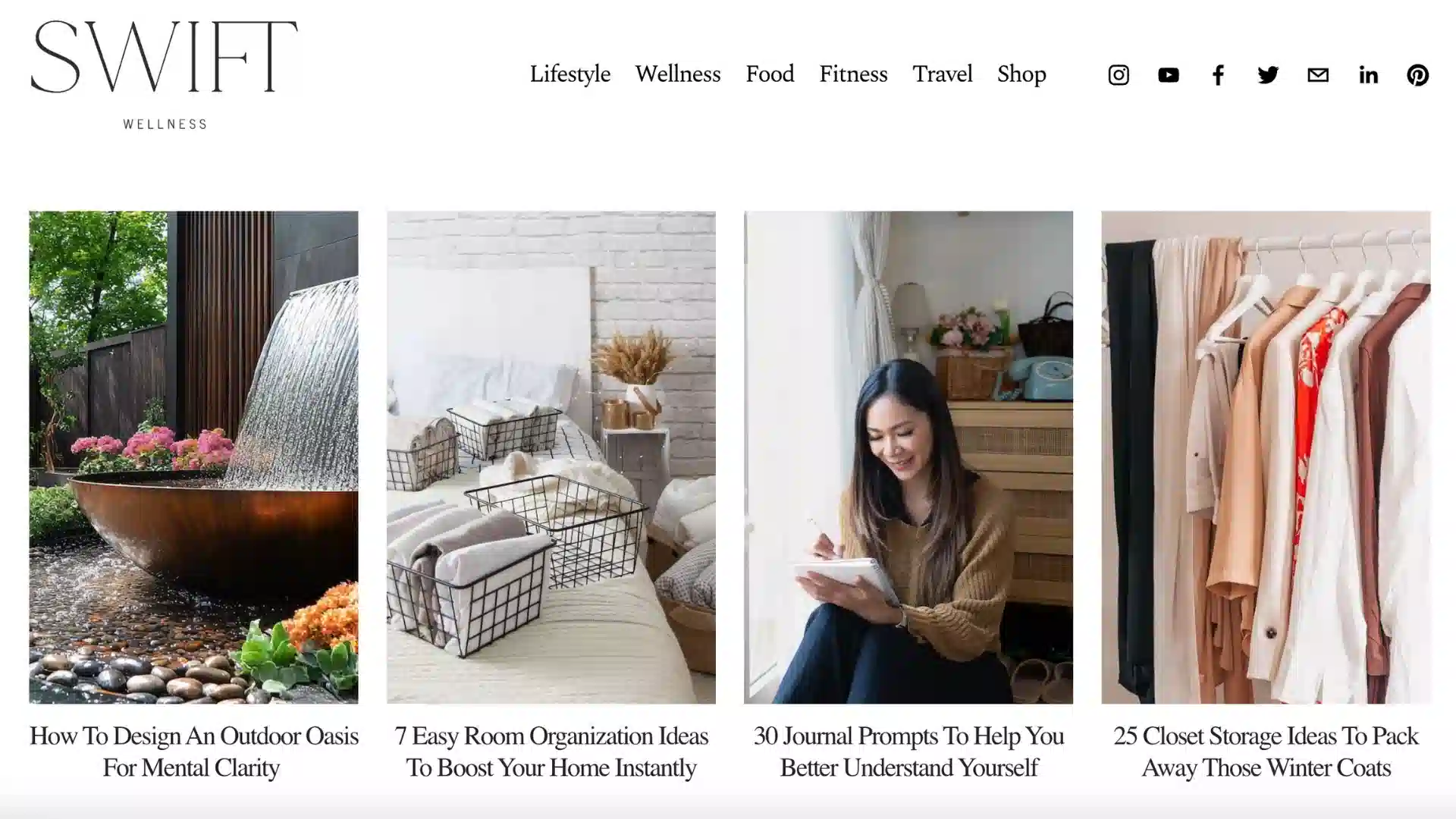
Build lasting value with content partners like Swift Wellness
Partnerships are strategic, relationship-based, and require a different mindset than simply turning on an ad campaign.
The bottom line: Marketing spend that flows solely into paid channels is at risk. Diversifying across performance-driven, lower-CAC strategies like partnerships helps you build a more resilient and efficient marketing mix.
2. Ignoring long-term value: Overlooking the full funnel
When you’re building a digital marketing strategy, it’s easy to focus on just one thing—like getting new customers or driving sales. But a common mistake is to ignore the vital journey between those two points.
This tunnel vision often means allocating too much budget to the early, visible stages of the funnel while neglecting the essential customer nurturing phase. Morgan points out, a key issue is focusing too much on the beginning while “ignoring the rest of the customer journey.”
The result? “Not enough attention is given to the subsequent stages… such as building desire, interest, and a strong retention effort.”
Ignoring the entire journey leads to lost opportunities to build relationships, raise lifetime value (LTV), and ultimately improve your return on marketing spend.
Consider the customer journey of someone buying a new handbag:
- Awareness: A consumer sees a “shopping haul” video from a fashion influencer on social media.
- Interest: Visits a review site for detailed product research.
- Desire: Reads a blog post from a fashion publisher comparing features and prices.
- Action: Finds a discount code from a coupon partner and completes the purchase.
- Loyalty and Re-Engagement: Shares an unboxing video with their followers, driving new brand awareness.

Comparison sites like SHOPSTYLE help shoppers compare and decide.
Overlooking the entire funnel means you might only credit the final conversion to the coupon partner, ignoring the crucial role of the influencer, review site, and publisher. This leads to a distorted view of what really works, potentially causing you to de-prioritize or cut budgets for channels that are essential for building awareness and nurturing interest.
Delgado adds that this kind of short-term thinking can be an issue. “Too often, we get focused on performance metrics like impressions or clicks… without regard to the lifetime value at acquisition of the customer,” she says.
This focus on immediate returns often leads marketers to “move high-potential, low-cost channels… to focus our budgets on channels generating immediate returns.” For real, sustainable growth, she advises, it’s critical to “look at it from both angles, including performance in the immediate and long-term.”
The bottom line: To optimize your marketing channels for sustainable growth, you must think beyond quick wins. A full-funnel approach helps you deliver value at every stage, preventing a leaky funnel and lowering costs down the line.
3. Cutting ROI too soon: Mismanaging partnership timelines
Here is where many performance marketers go wrong: They view partnerships as plug-and-play. Unlike paid marketing channels, partnerships take time to gain traction, but brands too often see them as quick campaigns and pull the plug before the real value shows.
This comes down to unrealistic expectations. Moore perfectly explains the pitfall: “Marketers often think that partnership programs will work like paid search and get results in 30 to 60 days.”
He argues that these relationship-based channels need “3 to 6 months to really grow.” He’s seen too many businesses “cut their partnership budgets too soon because they used paid channel expectations.”
The real value of partnerships is in their long-term potential. Moore adds, “With good partnerships, the results keep getting better over time.” A strong relationship you build with an affiliate today can lead to so much more down the line. Think referrals, content collaborations, and co-marketing opportunities for years to come. Unfortunately, many marketers only look at the short-term returns.
Creators like Tyler Haven craft content with real staying power
When managed with patience, partnerships provide compound value across the entire funnel.
Bottom line: To maximize your ROI, shift how you measure success. Only looking at early-stage metrics for partnership programs misses the bigger picture and can result in you missing out on significant long-term growth and compound value.
4. Attribution pitfalls: Ignoring partner contributions
Tying marketing spend to last-click attribution distorts your view of what really works. Channels like email, content collaborations, and backlinks might not seal the deal. But they’re key in helping customers reach the finish line.
For example, a customer might:
- See a brand mention in a podcast they listen to.
- Click a backlink in a blog post from a content partner.
- Open a promotional email.
- Finally, click a paid ad to make a purchase.
In a last-click model, the paid ad gets all the credit, and the brand overlooks the critical role of the podcast, blog, and email.
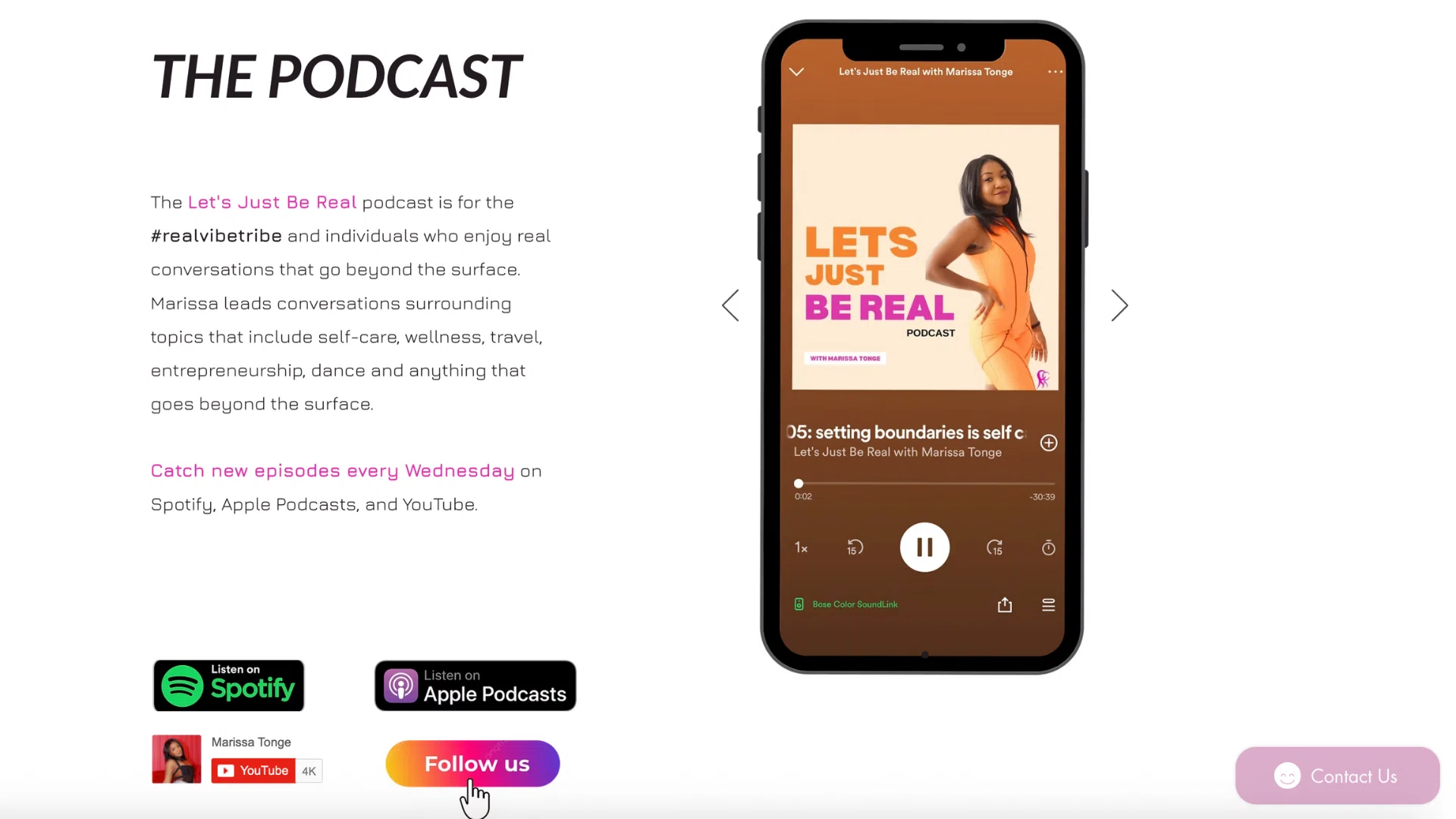
Partnering with podcasters like Marissa Tonge can help expand brand reach
This is why Smith insists that “Understanding the true incrementality of each channel is key.” He elaborates that the value of these indirect efforts is often masked, pointing out that “A strong brand presence from content marketing can reduce paid search costs, so cutting indirect channels might inadvertently increase overall expenses.” This means that reducing spending on content that builds trust might just force you to spend more on paid search to compensate.
Partnerships, in particular, often deliver benefits that traditional models simply don’t track. Hastings confirms this, stating: “Backlinks and brand mentions from partnerships can often boost your organic search results, but most marketers don’t take these benefits into account when they set their budgets.” This is a major omission, as strong organic rankings reduce your reliance on expensive paid channels over time.
Bottom line: A strong digital marketing strategy looks at more than final conversions. It considers how each channel contributes value—whether that’s building awareness, nurturing interest, or influencing the final decision. When you understand those total contributions, it’s easier to spend your budget where it makes the biggest long-term impact.
5. Reacting to short-term noise: Emotional budgeting
Every marketer has been there: CPCs spike, impressions dip, and the instinct is to react quickly. But knee-jerk budget shifts based on short-term metrics often do more harm than good.
One big pitfall is reacting “too emotionally—cutting top-of-funnel too fast or doubling down on short-term wins without looking at long-term CAC trends,” says Huang. Huang provides a compelling example:
This drive for “quick gratification” often leads marketers to redirect budget back to paid search or social media without thinking about long-term ROI, notes Aziz. He adds that another common mistake is “forgetting to refresh and optimize current content and partnerships,” which can lead to a significant drop in traffic and wasted initial investment.
The key to disciplined spending is understanding context. Hastings, an SEO Strategist at SmartSites, highlights the importance of this, stating that reacting to “short-term noise instead of long-term patterns” is a mistake she sees frequently.
Marketers often divert funds from channels that had a slow month or quarter without considering seasonality. This recency bias can “kill profitable partnership programs because they had one slow month, not realizing they were cutting during a natural seasonal dip.”
Bottom line: Smart marketing spend decisions come from disciplined, hypothesis-driven testing, not gut reactions. The brands seeing real ROI know how to zoom out and focus on long-term signals over short-term noise.
6. Patching vs. planning: Missing strategic resets
When performance dips, budget shifts tend to follow. Too often, though, these are reactive fixes rather than thoughtful realignments. It’s better not just to patch holes. Instead, see reallocation as a chance to rethink your entire marketing strategy.
A good question to ask yourself is, “Are my investments truly aligned with our growth goals?“
This is where affiliate partnerships’ inherent resilience truly shines. They’re based on aligned incentives, not the whims of an algorithm. Lebedenko explains the fundamental difference: “With paid channels, you’re renting reach that can evaporate with a platform tweak.”
He emphasizes that well-managed partnerships offer stability because “affiliates often build niche authority that can’t be easily disrupted by CPM spikes or social algorithm changes.”
Creators like The LKS Address define their space
Lebedenko has seen this in action, highlighting that the stability comes from relationships, not platform leverage: “Our best affiliates drive stable traffic even during major SERP volatility or ad auction inflation because their value comes from audience trust, not platform leverage.”
Bottom line: A true marketing spend strategy shouldn’t hinge on what’s trending or what spiked last week. It should focus on key priorities, sustainable growth, and long-term ROI. Strategic budget resets help you focus on these top priorities and create a mix that’s better adapted for the future.
What are the best strategies for marketing spend optimization?
The case for partnerships as a performance-driven solution
The strategic shift to partnerships is a high-ROI strategy. Partnerships have a financial edge: you only pay when they deliver, which is why they’re inherently more cost-efficient and resilient.
In fact, an analysis of customer journeys showed that 24% of conversions had partnerships as the sole channel in the path to purchase. This outcome-based structure makes them one of the safest bets for scalable growth with minimal upfront risk. Here’s why more brands are making the switch.
Performance-based pricing makes partnerships a safe bet
The most appealing financial aspect of affiliate partnerships is the outcome-based pricing model. It’s marketing with minimal upfront risk. Unlike traditional advertising, where you pre-pay for visibility, partnerships guarantee that your investment only goes toward proven success.
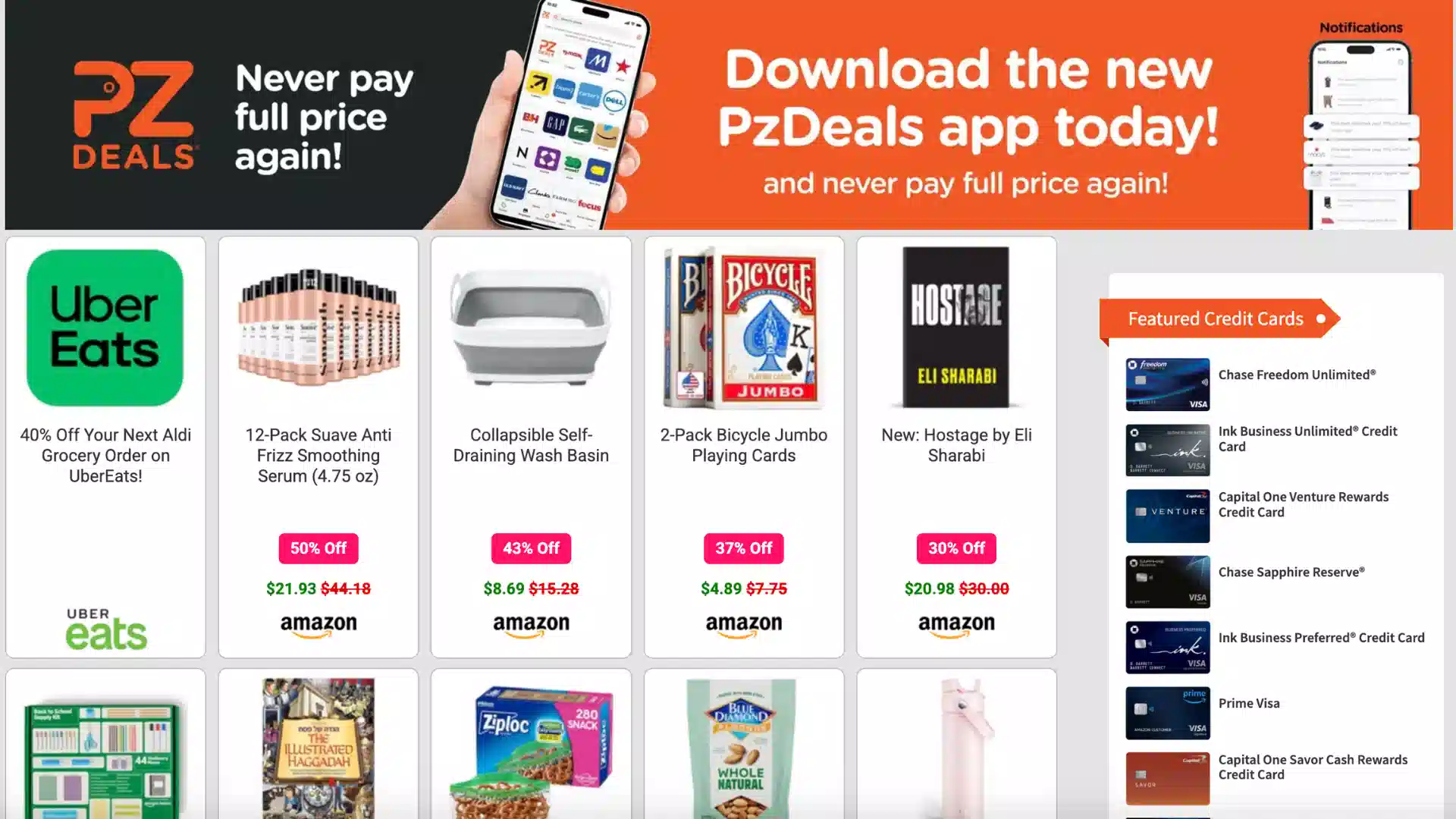
Coupon partners like PZDeals turn browsers into buyers
As Hastings explains, “Partnerships only cost money when they bring in sales or leads, but paid channels charge you whether or not they do.” This natural alignment is crucial. When competition for limited budgets heats up, paid channels usually get more expensive.
In contrast, partnerships work better when focusing purely on results. Plus, Hastings notes, these programs create owned media relationships that aren’t dependent on fluctuating algorithms, ensuring your connection lasts regardless of platform changes.
This performance structure shifts the cost model from a risky expense to a calculated investment. It virtually eliminates the gamble associated with traditional campaigns.
Morgan highlights that affiliate partnerships “are scalable with minimal risks since the relationship is completely performance-based.” If an affiliate yields no results, you pay little to nothing.
Morgan sums it up perfectly: “There’s no gamble beyond the small commission for the affiliate’s successful efforts.” This makes scaling incredibly safe. You can expand your partner network, knowing your costs are perfectly tied to the revenue you generate. It’s the ultimate financial safety harness for growth.
In action: OLIPOP uses a hybrid compensation model to deliver 982 percent ROAS through creator partnerships
As brands look beyond paid ads, performance-based partnerships are proving to be powerful growth engines. Functional soda brand OLIPOP is a standout example.
To scale its creator program, OLIPOP embraced a hybrid compensation model.
- Free product: Creators received complimentary products, such as $36 variety packs.
- Baseline commission: A guaranteed ten percent commission was paid on any sales they directly drove.
- Performance bonuses: High performers earned additional bonuses, providing a clear incentive to go beyond basic posting and maximize sales efforts.
This outcome-based strategy aligned costs with results. Instead of paying upfront for reach, OLIPOP only paid when creators delivered real value, through engagement, conversions, and ultimately, revenue.
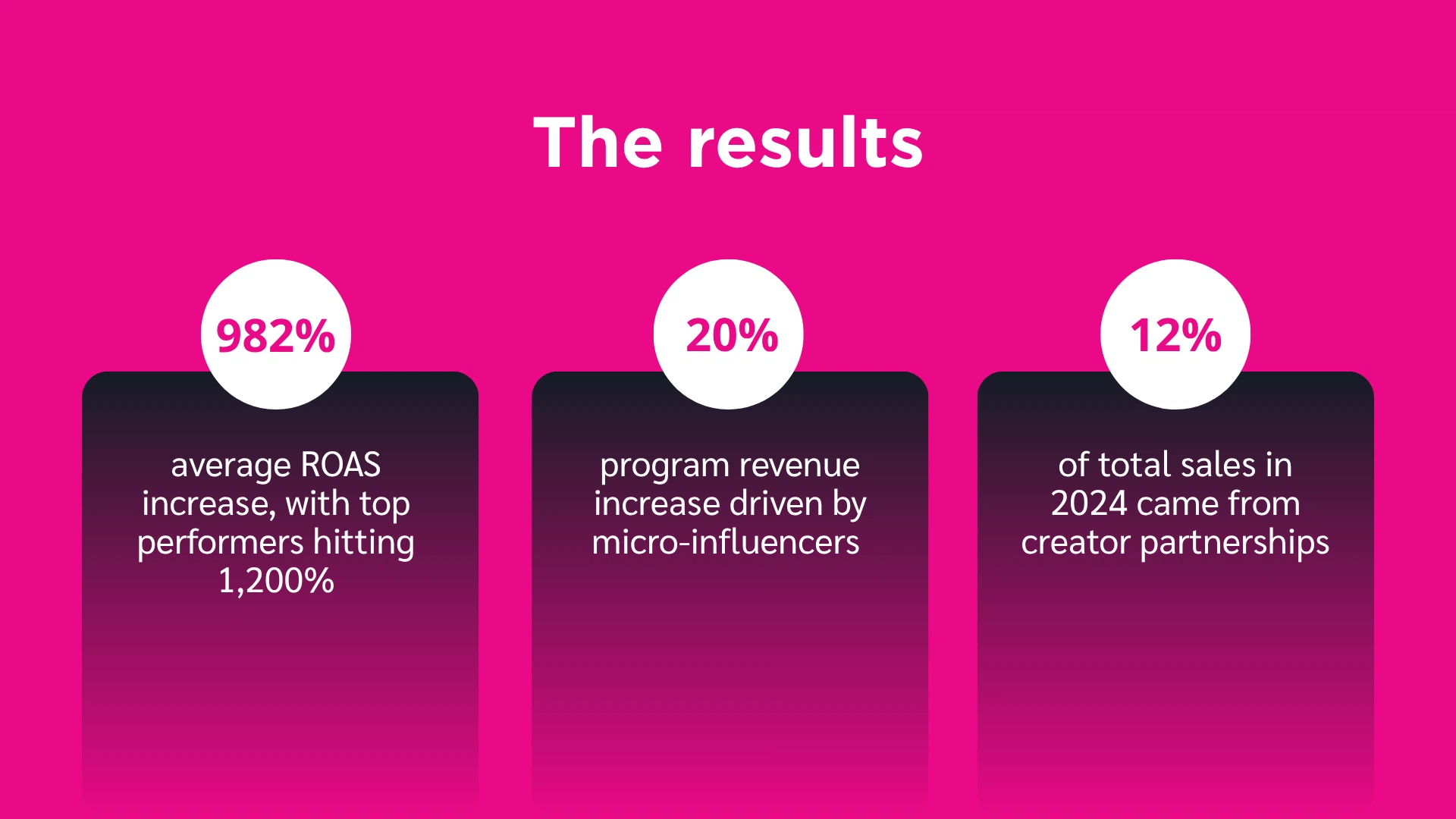
Partnerships are a long-term scaling engine
The great thing about a partnership strategy is that it doesn’t just save you money now; it builds future momentum and sustainable growth.
Think about the trap of paid channels: your results are temporary and disappear the second you stop spending. Partnerships create what’s called long-tail results.
As Austin notes on the longevity of partnerships: “A podcast guest spot or an affiliate’s email campaign can keep driving traffic, leads, and even revenue weeks or months later… without more spend.”

Email partners like DollarFlightClub can drive long-term traffic, leads, and revenue.
Imagine content you created or an event you hosted continuing to generate interest years later just because a partner is still promoting that evergreen material. That’s pure, sustained scalability without continuously injecting cash.
Scaling trust and building momentum
Beyond the initial content longevity, partnerships are also a safer and more stable way to scale your brand’s authority.
Chasiotis hits on two major points here. First, he emphasizes that partnerships “don’t get disrupted every time Google or Meta changes their rules.” That stability makes them a far safer long-term investment than constantly trying to keep up with platform algorithms.
Second, partnerships scale trust, which paid ads can never truly replicate. Chasiotis explains that whether you’re working with affiliate partners, integration alliances, or co-marketing efforts, “these relationships create momentum that compounds.”
When you trust a partner, your audience trusts them, and by extension, trusts you. During tough times, having a strong partner network is what keeps your pipeline healthy and alive without requiring you to constantly burn precious marketing cash. You’re leveraging mutual credibility to grow, which is the definition of sustainable, scalable expansion.
In action: Rosetta Stone scales its partnership program and achieves 87 percent revenue growth
Partnerships are only as scalable as the systems that support them. Rosetta Stone faced growth issues due to an outdated tech stack. It struggled with unreliable data, broken tracking, and reporting gaps, which made scaling with confidence nearly impossible.
To fix this, Rosetta Stone chose impact.com for an automated, data-driven solution. This move gave the brand complete control and visibility over its partner ecosystem and helped scale its program. The company achieved $120,000 in cost savings through streamlined operations.
- Reliable tracking offered a solid foundation for validating sales data confidently, preventing fraud, and ensuring compliance with all affiliate agreements.
- Key reporting tools allowed the team to optimize partnerships, invest in high-performing partners, and fairly reward all partner contributions.
- Protect features flagged and screened affiliate activities, ensuring all partners uphold the program’s terms and conditions.
- Marketplace identified and connected the team with potential collaborations, successfully expanding their partner portfolio.
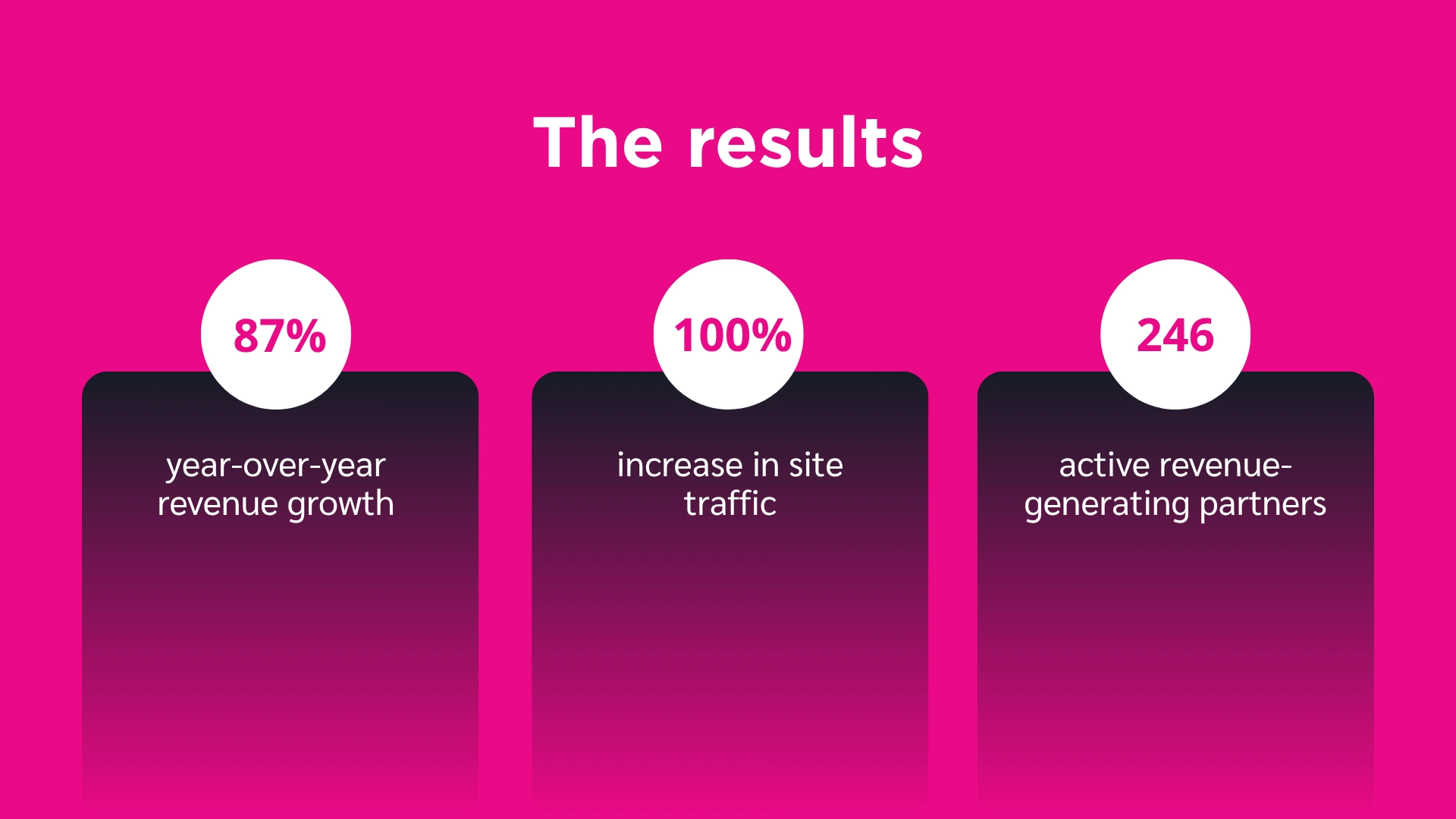
Partnerships thrive when economies falter
When budgets tighten and every dollar is scrutinized, partnerships shine. Partnerships are built to be cost-efficient and incredibly resilient because you only pay for actual results.
It’s about ditching the risk. Azis sums it up perfectly: “Partnership solutions, specifically affiliate marketing, are less vulnerable since they are performance-driven models; advertisers only pay for real conversions, not impressions or clicks.”
Creators like Merv the Pet receive compensation—from fixed commission to gifts—for their traffic-driving content.
Think of how much waste that model cuts out. Your budget is working harder, tracking key metrics like AOV, conversion rate, and CLV to ensure you’re generating higher ROI even when the market is volatile.
The advantage of diverse risk distribution
When you cut budgets for paid channels, your reach vanishes immediately. But Moore argues that partnerships are “recession-proof by design,” making them a better bet when times are tough. His logic? “Partnership programs get stronger when times are tough because partners are more motivated to get results—they only eat when you eat.”
Partnerships are a brilliant way to diversify your risk. Instead of betting everything on Google’s auction system or social media’s ever-changing algorithm, you’re “spreading the risk across dozens or even hundreds of partners,” as Moore puts it. If one affiliate drops the ball, the others are there to pick up the slack, protecting your overall performance.
Agility, trust, and quick moves
This diversification also gives you something paid channels can’t match: agility. Allsopp points out that affiliate programs naturally provide exposure through a wide, decentralized network of “content creators, influencers, review sites, and niche publishers.” This setup minimizes your exposure to a single platform’s major volatility.
What’s even better for your brand right now is the trust factor and speed. Allsopp highlights that “Affiliate partners tend to respond quicker, regionalize messaging, and are more trustworthy.”
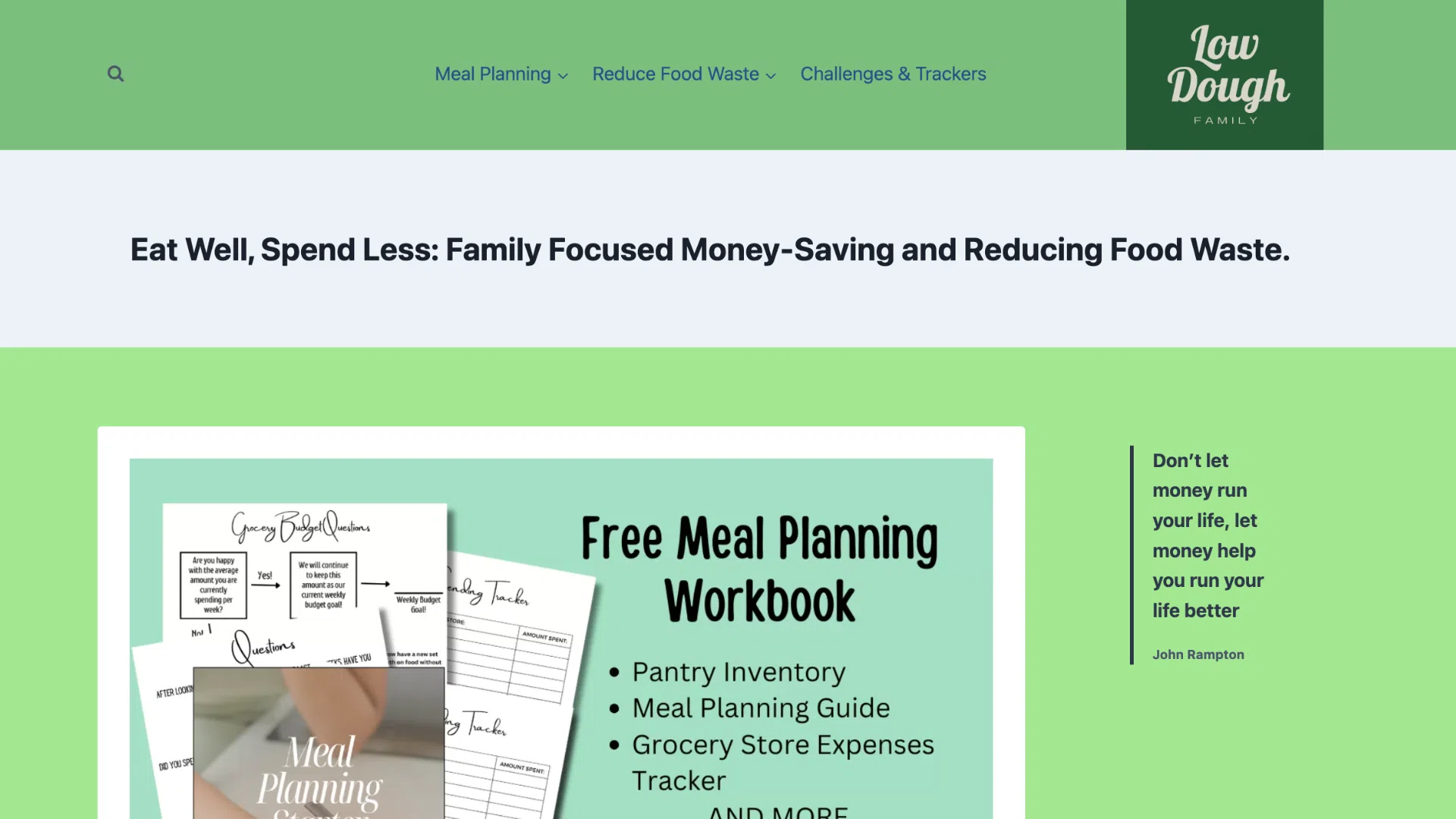
Working with content partners like Low Dough Family gives you access to their trusted audience.
Partners can adapt their communication in real-time to changing consumer behavior, giving your brand a flexible and scalable marketing infrastructure exactly when you need it most. It’s a win-win for efficiency and responsiveness.
In action: Resident merges affiliate and influencer marketing for a full-funnel advantage
Resident, a direct-to-consumer (DTC) mattress and bedding brand (including NectarSleep and DreamCloud), needed to enhance brand recognition and drive sales in a competitive market.
While user-generated content (UGC) and influencer posts boosted awareness, traditional affiliates and paid media delivered stronger conversions. The brand needed a full-funnel strategy to integrate the authentic content from influencers with the strong conversion power of affiliates.
Resident integrated its influencer program with its affiliate channel to build a steady flow of high-quality UGC for paid media and across the sales funnel. This was achieved by:
1. Creating a UGC library: Influencers created diverse, evergreen content that was used across the affiliate program, specifically for paid media ads. This content guided consumers and instilled purchasing confidence.
2. Streamlining partner experience: Using the impact.com platform to centralize recruitment, contracting, communication, and performance tracking simplified the process and built sustainable, long-term relationships with both influencers and affiliates.
3. Implementing full-funnel engagement: Content from influencers and affiliates was strategically used for every stage:
- Awareness: Influencer content introduced the brand.
- Consideration: Affiliates provided comprehensive guides and reviews.
- Decision: Influencers and affiliates used testimonials and comparisons to demonstrate product effectiveness.
- Retention: Partners created guides and tutorials to add value for existing customers.
The results:
By merging the programs and optimizing paid media with authentic UGC, Resident transformed its partnerships into a profitable, full-funnel campaign:
- Increased profitability: The value of each post and video was doubled, significantly boosting profitability, whereas previously the influencer program barely broke even.
- Improved ROI: An ad featuring influencer content generated profit with a Return on Ad Spend (ROAS) of 1.08, compared to a highly produced ad that didn’t break even (ROAS 0.89).
- Sustainable content asset: The strategy created a valuable, always-on library of evergreen UGC for future campaigns.
Budget reallocation: Identifying, calculating, and shifting spend
When marketing budgets are tight, cutting costs isn’t the only option. The smarter move is to strategically shift funds to channels that yield better, lasting results. This framework will help you make those informed decisions. It shows you how to examine performance data to see what works and what doesn’t, and make confident, data-driven shifts.
Identify underperforming channels
To make smart decisions about shifting your marketing budget, you first need a clear, objective view of what’s working and what isn’t. This process is all about isolating the channels that are dragging down your overall performance.
Start with a health check of your performance analytics to evaluate channels that show warning signs. Specifically, look for:
❌ Diminishing ROI: The overall Return on Investment is shrinking over time.
❌ High Customer Acquisition Cost (CAC): The cost to acquire a new customer is becoming unsustainable or significantly higher than your Customer Lifetime Value (CLV).
❌ Stagnant growth trends: Despite continued or increased investment, the channel has hit a ceiling and isn’t scaling effectively.
3 metrics marketers should prioritize when identifying underperforming channels
1. Customer lifetime value (CLV)
What is it? The total revenue a business can reasonably expect from a single customer throughout their relationship.
Why is it important? It shows customers’ profitability over time from each channel. A channel may seem costly, but it could still perform well if it attracts loyal, high-value customers.
2. Return on ad spend (ROAS)
What is it? The gross revenue generated for every dollar spent on advertising.
Why is it important? It’s the most direct measure of short-term ad efficiency. A declining ROAS indicates the channel is becoming less profitable or scalable.
3. Cost per acquisition (CPA) stability.
What is it? How consistently and affordably you can acquire a customer through a specific channel over time.
Why is it important? High or fluctuating CPAs make it hard to forecast budgets and plan for growth. Volatile or increasing CPA is a major warning. It suggests the channel is experiencing high auction competition or audience fatigue, making it unsustainable.
Actionable strategies to implement
Segment your data: Don’t just look at the high-level channel performance. Segment by campaign, audience, and even creative. The problem might not be the channel itself but a specific, poorly performing ad set within it.
Leverage platform reporting: You shouldn’t be piecing together spreadsheets. Use platforms designed for this, especially for your affiliate or partnership marketing. For instance, platforms like impact.com have built-in reporting [Performance and Optimize Reporting] that provides a unified, transparent view of partner performance metrics like conversions, revenue, and payout.
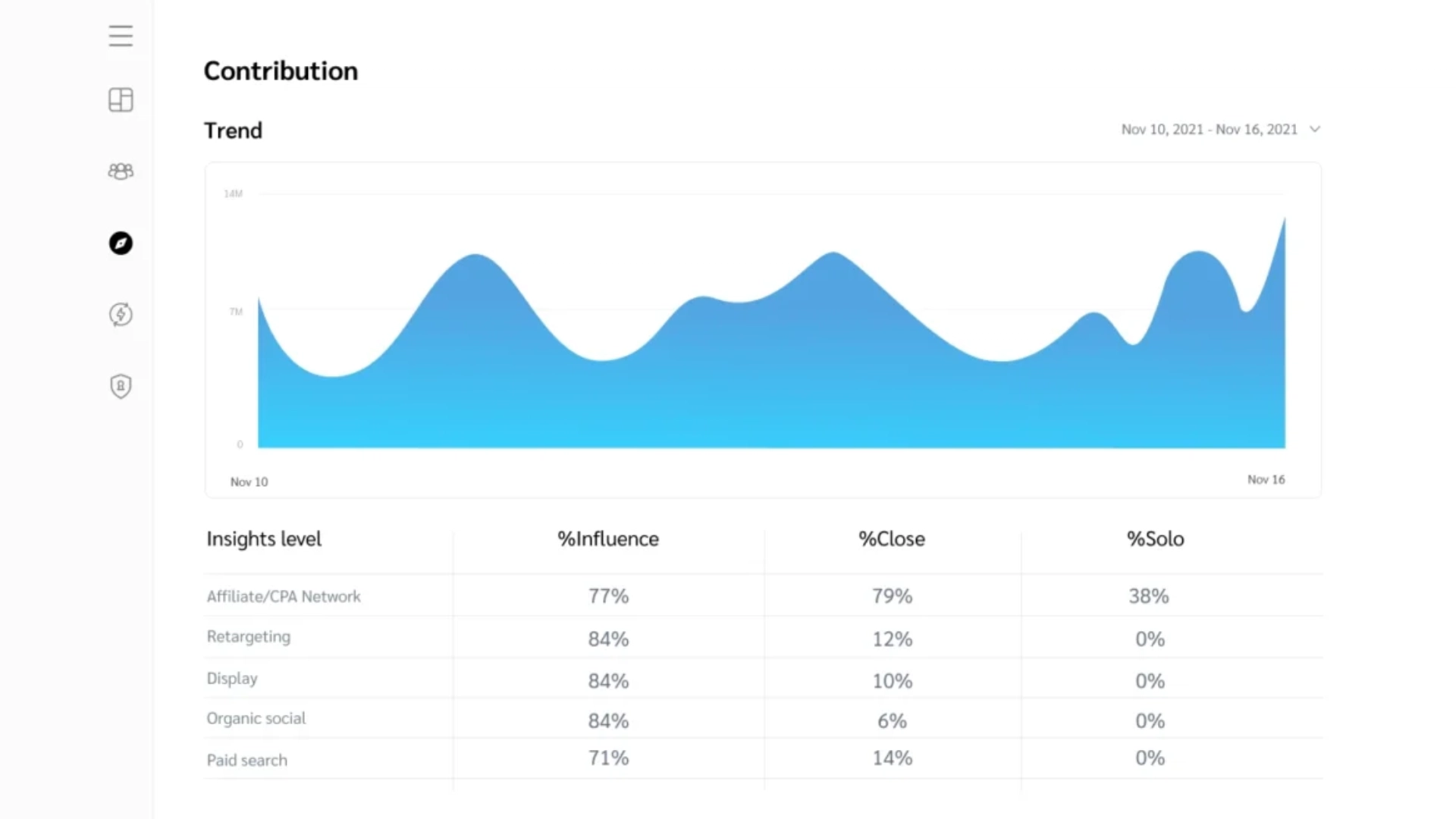
The Contribution Report shows which partners deliver incremental value throughout the funnel.
Establish clear benchmarks: Define what “underperforming” means for your business. Is it a ROAS below $3:1? A CAC above $50? Having a clear threshold allows for quick, non-emotional decisions about where to reduce spending and reallocate those funds to better-performing areas.
Make smarter budget allocation decisions with data
Instinct and experience matter, but smart budget decisions start with data. Your objective here is to leverage advanced tools and methodologies to make informed budget reallocation decisions.
You are shifting from looking in the rearview mirror (historical ROAS) to using a GPS (predictive modeling) to guide your future spend. To maximize your ROI and minimize risk, consider these three advanced methodologies:
Marketing Mix Modeling (MMM)
Marketing mix models evaluate how each marketing channel contributes to overall performance. You can identify which channels consistently drive customer acquisition and return on investment, taking into account external factors like seasonality and competition.
Key considerations for performance marketers
Don’t wait for perfection: Start small by modeling core channels and expand gradually; an imperfect model that guides directional decisions is better than no model at all.
Validate external factors: To prevent misinterpreting performance data, ensure your model accurately accounts for non-marketing influences like seasonality, competitive spending, and macroeconomic events.
Combine with granular data: Treat MMM as the “top-down” strategic view. Always cross-reference its findings with “bottom-up” data from marketing analytics for campaign-level confidence.
Use marketing analytics
Track real-time metrics like conversion rates and customer lifetime value (CLV) across your ad spend. By layering in historical data, you can spot patterns, predict future performance, and confidently shift budgets where they’ll have the biggest impact.
Key considerations for performance marketers
Focus on LTV:CAC Ratio: Make the Customer Lifetime Value (CLV) to Customer Acquisition Cost (CAC) ratio your primary budget driver. Channels that are expensive upfront but bring in loyal, high-value customers are worth scaling.
Prioritize transparency: Use platforms that offer a unified, transparent view of all partner performance metrics, including revenue and payouts, to avoid time-consuming spreadsheet reconciliation.
Assess incremental value: Move beyond simple conversions. Analytics should be geared toward identifying which channels deliver sales you wouldn’t have gotten otherwise—the true incremental value.
Incorporate machine learning
Machine learning (ML) algorithms reveal hidden inefficiencies and forecast the potential ROI of reallocation. These tools help automate the identification of underperforming campaigns and surface high-impact strategies marketers might overlook.
Why is it important?
ML can identify complex interactions between channels that a human analyst might miss. It introduces a predictive element, letting you model the financial outcome before you execute the reallocation.
Key considerations for performance marketers
Use ML for automation: Deploy ML to automate the partner scoring and campaign identification processes, freeing up your team to focus on strategic relationship management and scaling.
Predictive, not reactive: Leverage ML’s predictive capabilities to model the financial outcome of reallocating budget before you make a single cut, moving your strategy from reactive to anticipatory.
Identify hidden interactions: Look to ML to surface complex interactions between channels (e.g., how content partnerships reduce your paid search costs) that simple human analysis might overlook.
Implement a phased reallocation approach
Once you have your data-driven plan ready, the smart move is to avoid immediate, large-scale shifts. Instead, adopt a Phased Reallocation Approach to validate your models and minimize potential risks. Think of this as a strategic, controlled rollout:
Phase 1: Launch a pilot budget
Begin by allocating five to ten percent of your total ad spend to a pilot partnership program. It creates a low-stakes environment where you can ensure your platform setup and tracking are accurate, and you can observe initial performance without disrupting your core business.
Phase 2: Reallocate from underperformers
Use insights from your earlier analysis to identify which marketing channels are delivering the lowest ROI. These should be the first to see budget reductions in favor of partnership testing.
Phase 3: Scale based on performance
You only scale what works. As you monitor those early-stage results, progressively increase allocations based purely on performance. Once the pilot ROI hits your established benchmarks, you have the data-backed confidence to scale the budget.
This commitment to data ensures that growth is supported by real-time results and that you only fully commit once the new channel proves its ability to sustain high returns.
Future-proof your investment: Risk management for partnership programs
Risk management is key as you scale your partnership programs. A few smart safeguards can help you diversify your approach, avoid common pitfalls, and build a sustainable and high-performing ecosystem. To build a truly resilient program, conduct a quick security audit of your partnership program:
Diversification and alignment audit
Goal: Protect against single-point-of-failure risk.
Action: Review your current partner roster. Is it a strategic mix of affiliate, influencer, and brand collaborations, or are you over-indexed in one area?
Tactic: Use automated tools to refresh your portfolio and quickly recruit high-potential partners across various niches.
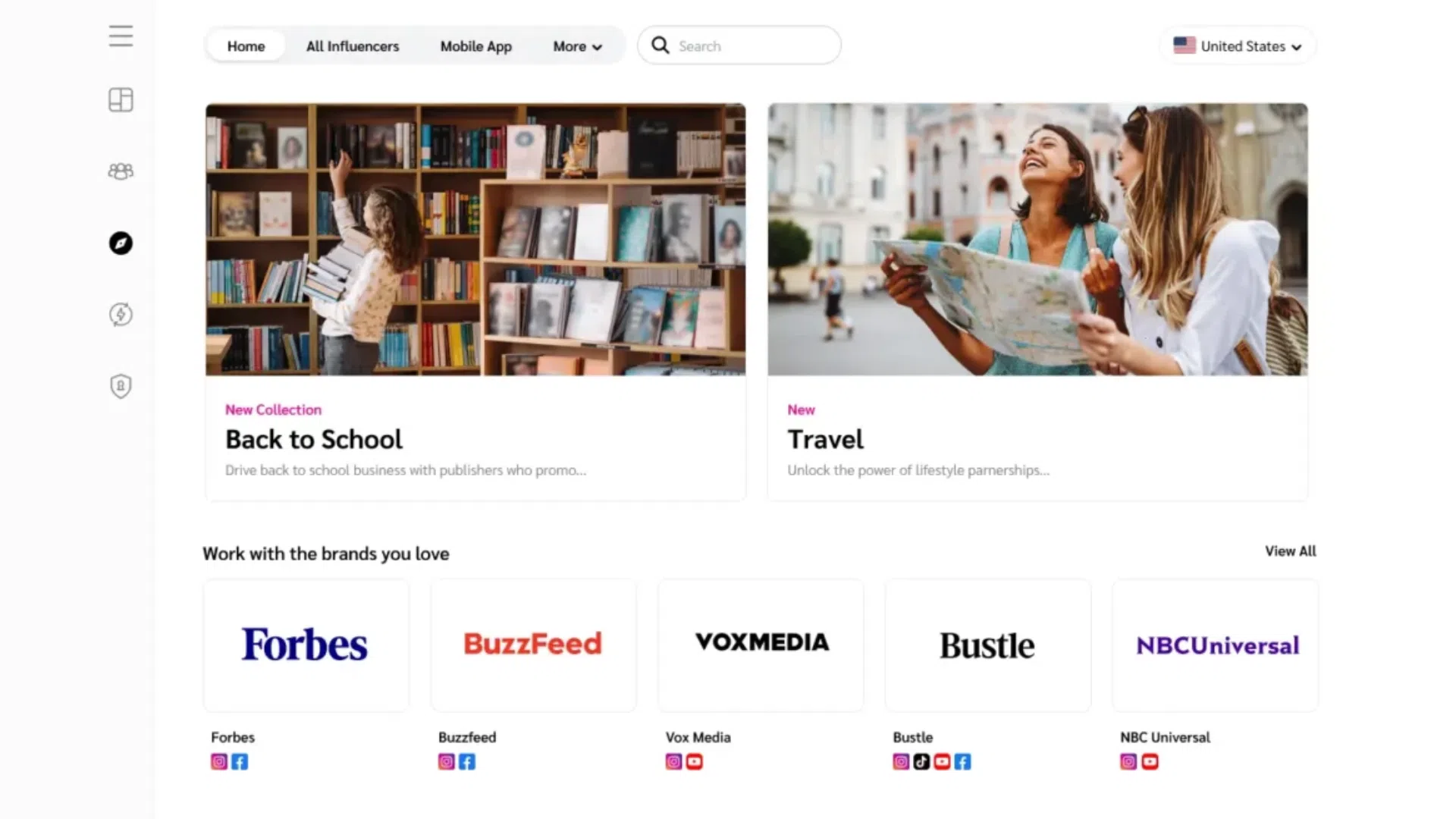
The impact.com Marketplace allows you to browse perfectly curated partner collections to create diverse partner portfolios.
Incentive alignment audit
Goal: Ensure motivational longevity and program scale by aligning compensation with business outcomes.
Action: Check your incentive model. Does it use a strict performance-based model (CPA, revenue share) to ensure both you and your partners are working toward the same goals?
Tactic: Evaluate your partner tiers and bonuses. Ensure that high performers earn more bonuses, providing a clear incentive to go beyond just posting and driving real value.
Red flag check: Immediately address misaligned incentives; you should only pay when partnerships deliver results.
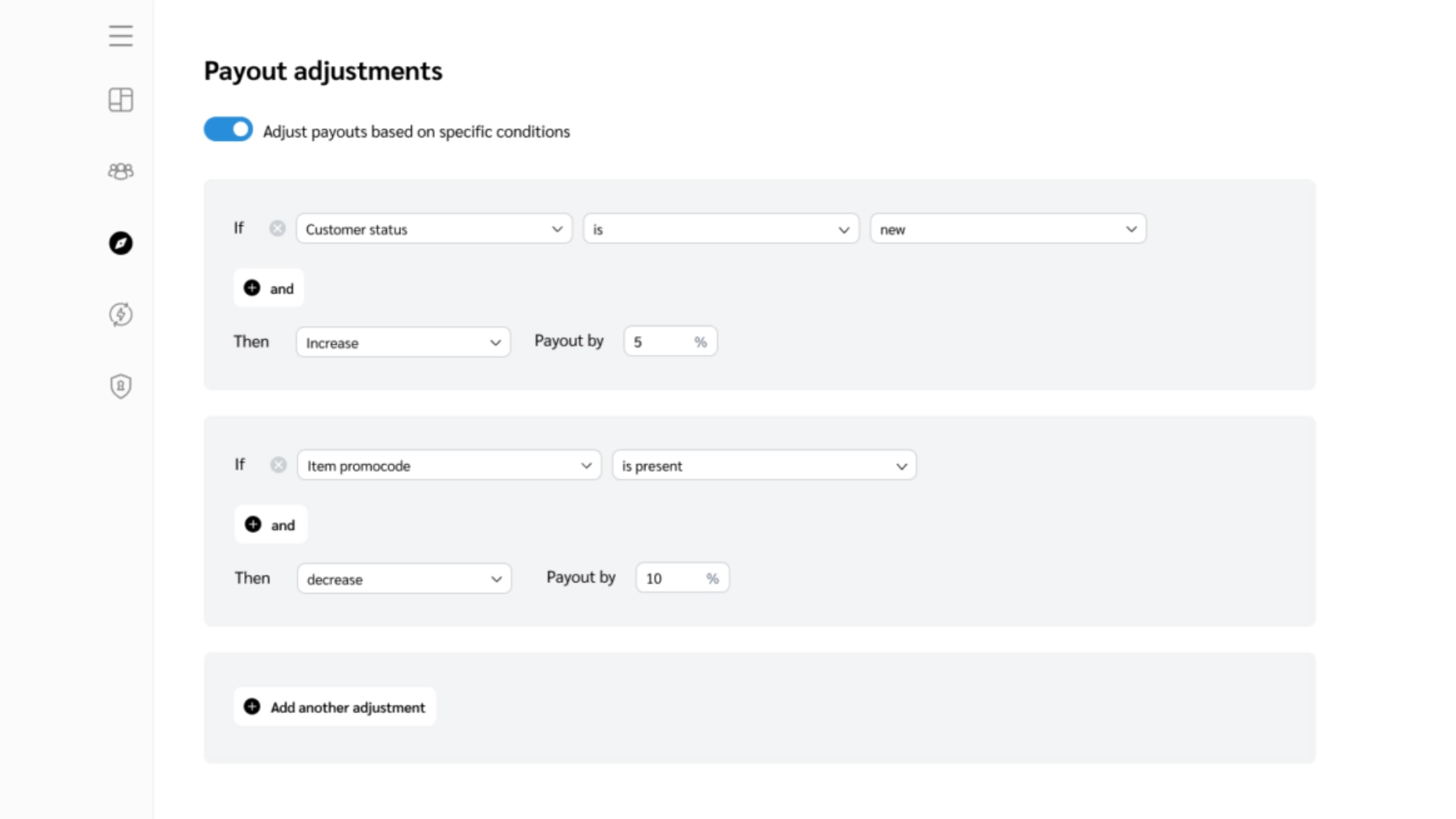
Dynamic Payouts automatically adjust partner commissions up or down by 100+ factors, such as: Customer-level and Order-level
Engagement and relationship audit
Goal: Build strong, long-term relationships that compound value and prevent partner drop-off.
Action: Evaluate your communication strategy. Are you providing the resources partners need to succeed?
Tactic: Use tools (like impact.com Engage) to automate onboarding with tailored welcome flows and educational content.
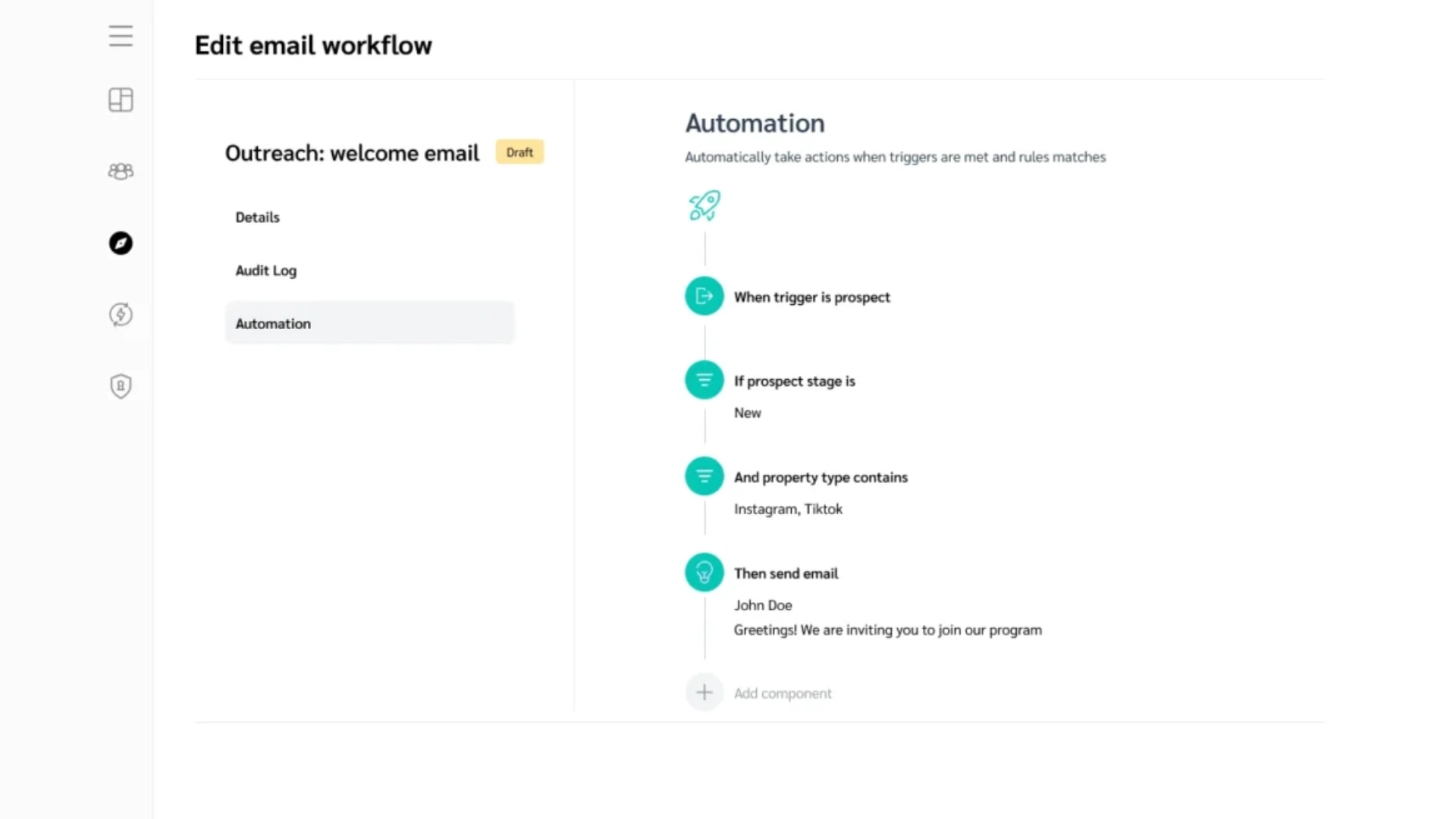
Automatically send emails, create tasks, change partner stage, and more when your partners perform (or fall behind on) certain actions.
Must-do: Schedule ongoing communication and promotions to keep partners aligned and motivated. Regularly share performance insights and updates in real time.
Legal and trust audit
Goal: Establish a strong, transparent, and compliant foundation.
Action: Verify all agreements. Are all your partnership agreements formalized and legally binding, and do you cover critical clauses like payment terms, IP rights, and termination clauses?
Tactic: Mandate regulatory compliance with local advertising laws, especially FTC disclosure requirements essential for influencer marketing.
Security layer: Deploy fraud prevention tools (like impact.com’s Protect capabilities) to monitor for invalid traffic or fake conversions that could inflate costs or damage brand trust.
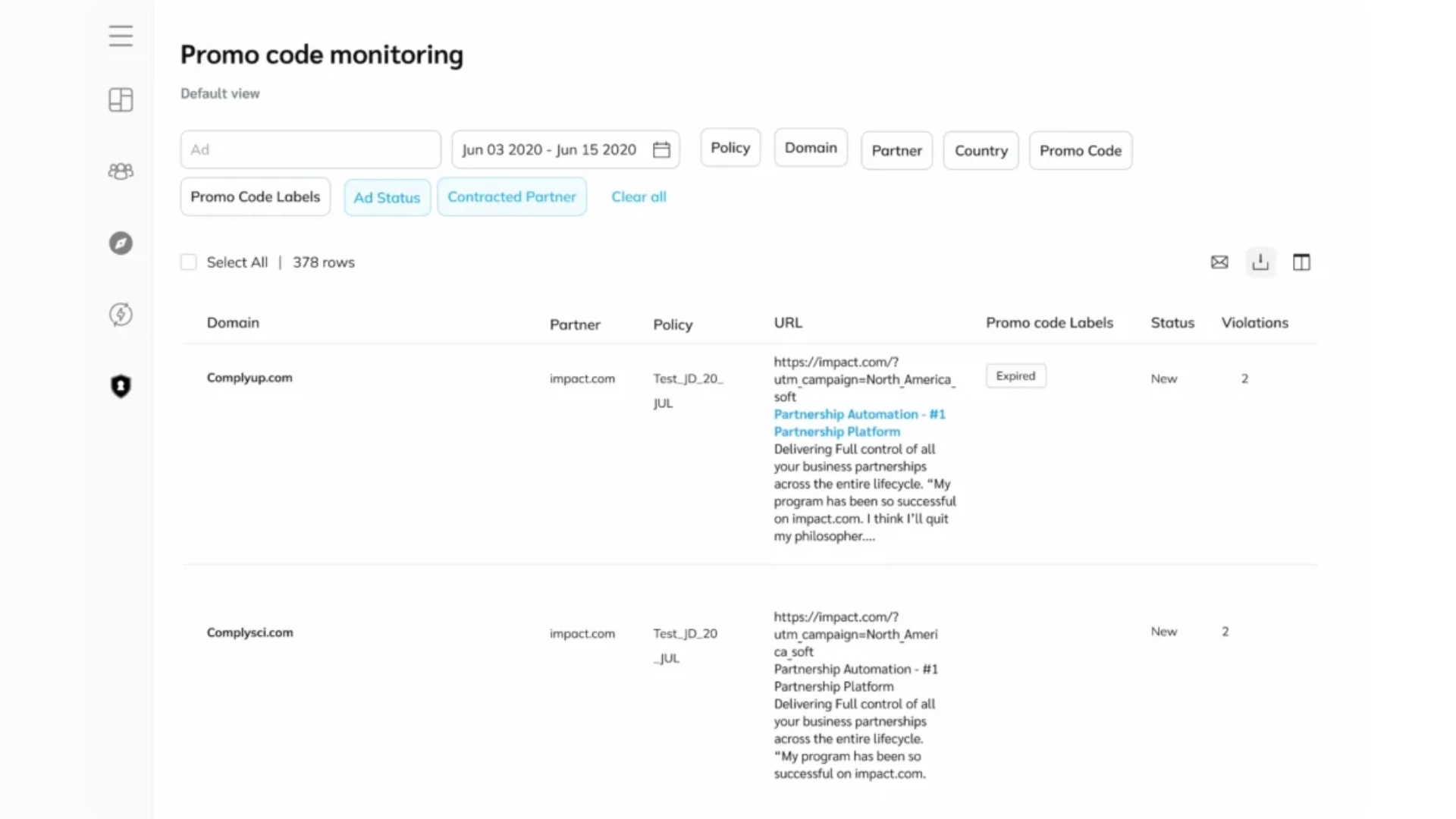
Features like Promo Code Monitoring help you prevent issues like shopping cart abandonment, reputation damage, and revenue loss.
Measurement and optimization audit
Goal: Use data to drive continuous, confident scaling.
Action: Confirm you are using advanced tracking tools to measure key metrics like CLV and ROAS accurately. Are you measuring true partner impact using incrementality testing, or are you still relying solely on last-click data?
Tactic: Implement incrementality testing (A/B testing on a larger scale) to assess the true, incremental value a partner provides, not just their last-click credit.
Efficiency hack: Leverage Optimize suites to get automatic recommendations for scaling efficiently or re-engaging underperforming partners.
How Merry People redistributed the budget for higher returns
The popular Australian gumboot brand, Merry People, initially grew through local farmers’ markets and then through digital marketing and online sales. However, to continue growing in Australia and build trust and brand awareness in newer international markets like the US and UK, their existing advertising channels weren’t enough.
The team needed a way to:
- Diversify its marketing mix by introducing a robust partnership program.
- Manage these new partnerships as efficiently as possible to maintain sustainable growth.
- Drive incremental growth sustainably, specifically aiming to increase partnership revenue by 65 percent while maintaining a strong return on ad spend (ROAS).
The solution: A data-driven, dynamic partnership strategy
Merry People used impact.com to establish a partnership channel from the ground up. Smart, real-time budget allocation
The core of their budget strategy was a shift from risking a large upfront marketing campaign budget to investing in performance in real time. By using impact.com’s automated tracking and management tools, Merry People implemented a dynamic, data-driven partnership strategy:
Testing and comparing: They could test new partnerships and receive real-time insights into individual partners’ performance. This allowed them to adjust their direction and seize high-performing marketing opportunities immediately.
Performance-based investing: Instead of pre-allocating large, fixed budgets, they invested in each post, media highlight, and partner collaboration as it performed.
High-yield replication: The performance of an offer, such as one via a credit card loyalty program, quickly provided crucial insight. This guided their future strategies, ensuring the team sought out similar, high-yield opportunities. The team’s budget was always chasing proven success.
Diversified partnerships for targeted reach
To expand their consumer base beyond their established 35+ female demographic, Merry People used a two-pronged approach for their partnerships:
Niche audiences: They collaborated with content influencers, bloggers, and reviewers who had niche audiences (like gardening enthusiasts and dog owners) that resonated with a slightly broader target demographic of women between 25 and 45.
Broad credibility: They simultaneously built relationships with massive publishers like The New York Times and Time Inc. These partnerships, which resulted in valuable placements like a New York Times “best of” piece driving weekly sales for over a year, were crucial for establishing brand credibility in new markets. The flexible commission and contracting options through impact.com made these placements financially viable.
This approach resulted in the budget being used effectively for both specific conversions (via niche partners) and broad, long-term brand equity (via massive publishers). They further diversified by focusing on affiliate partners with loyalty programs using a points system and select cashback partners, moving away from relying solely on discounts and sales.
The outcome: Doubled revenue and stronger ROAS 🚀
The focus on partnerships proved to be a powerful budget optimization channel. Merry People didn’t just meet their initial ambitious goal of 65% growth; they far exceeded it:
- Partnership revenue doubled (2x) in Australia, the US, and the UK.
- This growth was achieved with a 25% stronger ROAS (Return on Ad Spend).
- Cashback and loyalty partners now contribute about 35 percent of total partnership revenue, achieving a conversion rate 42.5 percent higher than the year before.
- The brand onboarded 334 new partnerships and welcomed younger, more diverse shoppers, fulfilling their goal of reaching a wider audience.
By shifting their budget toward a flexible, data-driven partnership model, Merry People achieved rapid, global growth efficiently and sustainably. This case definitely shows that partnerships are a strategic channel for budget optimization that yields outstanding results!
FAQs
Small businesses can start by identifying underperforming channels and reallocating a small portion of their budget, around 5–10 percent, to performance-based partnerships. Focus on low-risk, high-return strategies, such as affiliate and influencer programs, that only incur costs when they drive results.
Try partnering with micro-influencers, running joint campaigns with complementary brands, or launching referral programs. You can also repurpose content across channels and use performance-based partnerships to minimize upfront spend.
Data privacy regulations can limit tracking capabilities, making it harder to measure performance accurately. To stay compliant and effective, use first-party data, transparent consent practices, and privacy-safe platforms that support accurate attribution and reporting.
Team collaboration ensures marketing, finance, and partnership teams align on goals, performance metrics, and spend. When everyone shares insights and works from the same data, it’s easier to identify waste, build on what’s working, and achieve better ROI.
Marketing optimization is the process of improving your marketing efforts to get better results with fewer resources. It involves analyzing performance data, testing different strategies, and reallocating budget to the channels, partners, or campaigns that deliver the highest return on investment (ROI).
Marketing optimization is important because it helps you get more value from your budget. By focusing on what works, and cutting what doesn’t, you can lower customer acquisition costs, improve ROI, and drive sustainable growth without overspending.
Conversion rate optimization (CRO) is the process of improving your website, landing pages, or campaigns to increase the percentage of visitors who take a desired action, like making a purchase, signing up, or clicking a link. It’s about making small tweaks that lead to big results.
Businesses can start small by focusing on high-impact, low-cost tactics, like refining their messaging, repurposing existing content, and using free or affordable analytics tools. Prioritizing what works and testing consistently helps stretch limited resources further.
To optimize a marketing budget, identify underperforming channels, double down on what’s working, and reallocate spend based on data-driven insights. Use tools to track ROI, run tests to measure impact, and align spending with business goals.
Drive smarter growth with partnerships
Traditional paid channels aren’t going anywhere. But they’re no longer the only answer. Marketers need smarter, more scalable strategies as customer acquisition costs rise and returns become harder to predict.
Partnerships offer exactly that. They’re performance-based, cost-efficient, and built to grow alongside your business, not just your ad spend. Whether it’s driving conversions through niche influencers, scaling efficiently during economic shifts, or unlocking long-term value through affiliate programs, partnerships are a powerful lever in any marketing strategy.
But tapping into that potential requires more than a quick pivot. It takes data, testing, and the right tools to track what’s really working.
Ready to optimize your budget with partnerships that actually perform? Explore impact.com to find the tools, resources, and expert consultation you need to start your partnership program today.
Want to scale your program like Rosetta Stone or OLIPOP? Access more in-depth insights on partnerships now.
- Performance marketing explained: Types, benefits and key metrics | Blog
- How modern marketers can boost campaign effectiveness with performance marketing attribution | Blog
- Searching smarter: How to identify top-performing affiliate brands to promote on impact.com | Blog
- Advertising is dead: Partnerships are the new currency of consumer trust | eBook
- Affiliate marketing: How to give your business the strategic edge | eBook
- The incrementality playbook: Prove your affiliate revenue’s true impact | Research report









